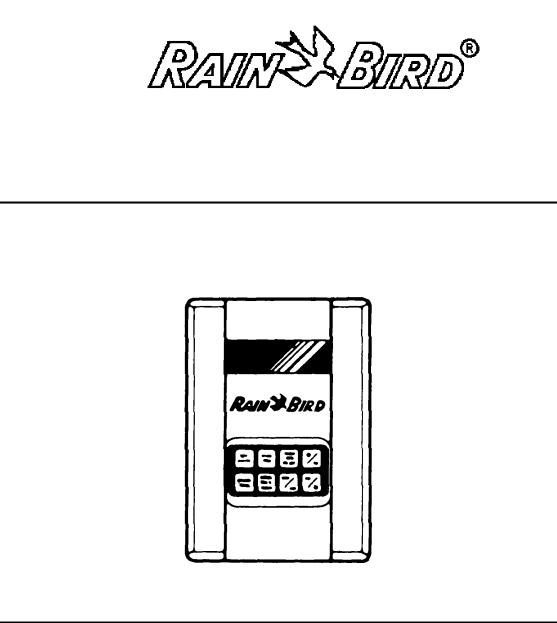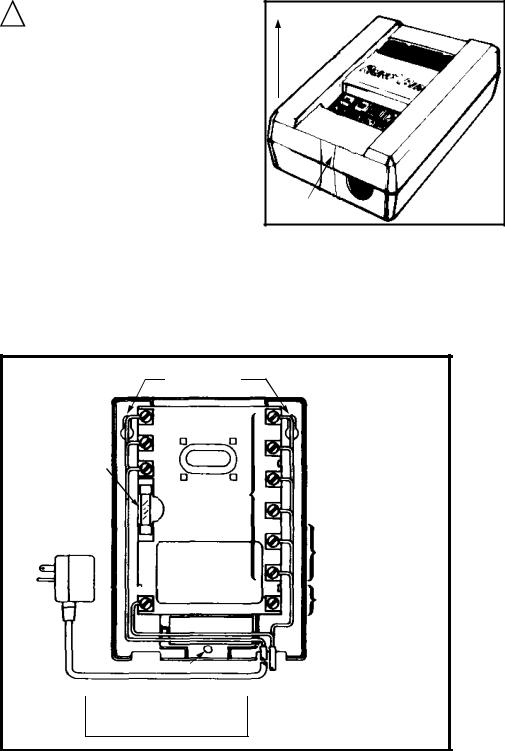RAIN BIRD PC-104, PC-106, PC-104-PS, PC-106-PS User Guide

RAIN CLOCK
OWNERS MANUAL
SPRINKLER SYSTEM CONTROLLER
RAIN CLOCK MODELS
PC-104 |
4 |
Station |
PC-106 |
6 |
Station |
PC-104-PS |
4 |
Station with Pump Relay |
|
Circuit |
|
PC-106-PS |
6 |
Station with Pump Relay |
|
Circuit |
|
Rain Bird Sales, Inc.
Customer Support Center
6991 E. Southpoint Rd., Bldg. #1, Tucson, AZ 85706
1

PC-104/106 SPRINKLER SYSTEM CONTROLLER
INSTALLATION INSTRUCTIONS
Rain Bird Rain Clocks are designed for use with all standard residential 24 volt AC electric valves regardless of brand. However, some older brass electric valves and commercial duty plastic valves may have power requirements higher than this series is designed for
STEP 1: MOUNT THE TIMER
Location: Select a location inside a building, and within six feet of a grounded electrical outlet. This is not an outdoor timer. Do not mount it where it is exposed to any of natures elements. If it must be outside,
be sure to use an outdoor enclosure and a weatherproof electrical connection.
Cover Removal: Remove the front cover of the timer by depressing the bottom tab and lifting as shown in Figure 1.
Lift
Press Here |
FIGURE 1 |
|
Mounting: Mount the timer to a wall using two #10 screws installed at centers
3 13/16" apart at eye level. Use plastic anchors to secure screws if the wall is plastic or masonry. Leave the screw heads extended ¼ " and hang the Rain Clock using the keyhole slots on the back. Install a third screw through the mounting hole (located below the battery area) to secure the timer to the wall.
Mounting Holes
|
FUSE |
|
|
|
|
|
1/2A 250V 3AG |
YELLOW |
|
1 |
|
|
|
|
|
|
|
|
OR |
RED |
|
2 |
|
|
|
|
|
||
|
|
|
|
|
|
|
FUSE |
|
|
|
|
|
3/4A 250V 3AG |
BLUE |
|
3 |
|
|
|
|
Station |
|
|
|
AS INDICATED |
|
|
||
|
|
|
|
||
|
|
Output |
|
|
|
|
ON THE UNIT |
|
|
|
|
|
|
Terminals |
4 |
|
|
|
|
|
|
||
|
|
|
|
|
|
Plug Transformer |
|
|
5 |
|
|
into 120 volt AC |
|
|
|
|
|
electrical outlet |
|
|
|
ONLY ON SIX |
|
|
|
|
|
6 |
|
|
|
|
|
STATION MODELS |
|
Key Pad
|
MV |
ONLY ON PUMP START |
|
|
|
|
|
MASTER VALVE MODELS |
9 Volt Battery |
|
|
Mounting Hole |
|
|
|
To |
|
|
Control |
|
|
Valves |
|
|
|
|
ATTENTION
!Battery must be installed to ensure proper operation.
FIGURE 2
2
STEP 2: CONNECTING THE WIRING
How to choose the right type of sprinkler wire: Use 18-gauge “bell,” “thermostat” or “underground burial” wire for the sprinkling systemBell. “wire” is available in single strands or twisted in 2 or 3 wire sets and can only be used indoors. “Thermostat wire,” the most common sprinkling system wire, is typically available with up to 7 wires twisted inside a brown PVC jacket (about
¼” in diameter), and is suitable for most indoor and conduit installations.
“Direct Burial” cable is similar to thermostat wire, except the jacket is made of a black Poly UV resistant material, and is suitable for any indoor or outdoor installation, including sunlight exposure. Each individual wire is color-coded.
Note: Some areas require by code the use of UL approved cable only. Most Direct Burial Cables have this approval. Most thermostat and bell wires do not. Important: 18 gauge wire or /larger is recommended for sprinkler system wire, allowing cable to be run up to 600’ without problems. Some thermostat wire that is referred to as “sprinkler wire” may actually be a smaller gauge (#19 or #20) and will not have the UL listing or the capacity to run long distances.
The number of wires needed is determined by the number of valves being wired, plus a common wire. For example, three valves in a grouping require a 4-wire cable since the 4th wire serves as the common wire. If a system had two valves in the front yard, and four in the back, the wiring could be run in one of two ways:
1)Use a single run or 18/7 (18 gauge, 7 wires) cable connected ‘in-series’ from the front valves to the back valves to the timer;
2)Use one run of 18/3 cable from the timer to the front valves, and one run of 18/5 cable from the timer to the back valves.
All wiring connections should be sealed with a water-tight connector. Cables that are run indoors should be properly secured with a staple or clip.
How to connect the valves: Each valve connects to the timer through two wires. One wire from each valve solenoid must connect to the output terminal of the timer. This is the “HOT” connection. The second wire of each solenoid must connect to the (COM.) common terminal of the timer. This is the
“COMMON” connection. If the valves are grouped together, it is easier to join the common from all valves and just run one wire to the timer’s (COM.) common terminal.
Note: Only one valve may be connected to each station output terminal.
3
STEP 3: CONNECTING THE TRANSFORMER
Refer to Figure 2 and connect the yellow wire to the terminal marked
"YELLOW," and red wire to the terminal marked "RED" and the blue wire to the terminal marked "BLUE." Caution: Always connect the wires before plugging in the transformer. If not, you run a risk of short circuiting the transformer and/or clock.
STEP 4: USING THE PUMP START CIRCUIT
Pump start or master valve capability is available only on the PC-106-PS and PC-104-PS models. This circuit allows the timer to be used in conjunction with a "pump relay switch" (Rain Bird model PCR-1) which when activated by the timer, will in turn activate the pump. The pump start circuit can also be used to operate a standard 24-volt "master valve."
The hot wire of the relay switch connects to the terminal marked "MV" The common wire connects to the regular system common wire or terminal. See the pump relay’s instruction booklet for details.
Caution: Be sure the total current draw of the relay switch plus the station valve doesn't exceed 650 milliamps.
Important: To avoid pump damage caused during a "default schedule," wire each unused station terminal to a terminal that is being used. This prevents the pump from operating against closed valves if the default program kicks-in during a power failure.
STEP 5: INSTALL A BATTERY
To ensure proper timer operation, install a 9-volt alkaline battery (not included) to the snap connector near the bottom edge of the control panel. In the event of a power failure the battery will maintain the programmed watering schedule in memory for up to 24 hours.
The battery will not allow the timer to open any valves, but the timer will remember the approximate time of the power failure. When the power resumes, an uncompleted watering cycle will be completed. If a watering start was missed during the outage, it will be initiated once the power resumes. After a power outage, reset the exact time of day.
If the battery is dead or doesn't have enough power left, none of theprogramming will be retained. In this event, the timer will revert to its "default program," which waters once per day, 10 minutes per station, 8 hours after the power is restored. All programming steps must be repeated.
4
